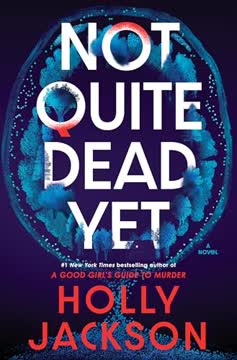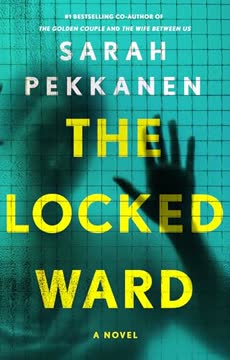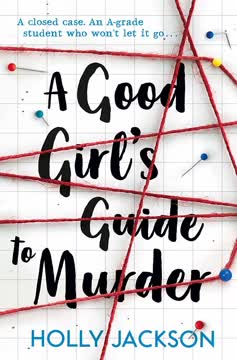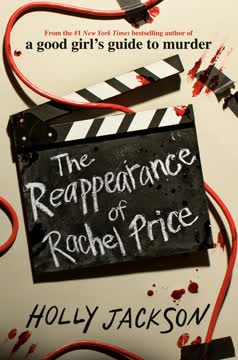Plot Summary
Halloween Fair, Old Wounds
Jet Mason, 27, returns to her small Vermont town for Halloween, still living at home after dropping out of law school. At the town fair, she navigates awkward encounters with her ex-boyfriend JJ, her brother Luke, and former best friend Sophia (now Luke's wife). Family tensions simmer: Jet feels like a failure, Luke is desperate to inherit the family construction business, and Sophia is distant. The night is full of small slights, old resentments, and the sense that Jet is stuck while everyone else has moved on. The fair ends with Jet feeling isolated, her relationships frayed, and a sense of foreboding in the air.
The Attack and Aftermath
After the fair, Jet returns home alone. She's ambushed from behind, struck three times in the head with a hammer, and left for dead. Her dog's screams alert neighbor Billy, who finds Jet bleeding out and calls 911. Jet is rushed to the hospital, barely surviving. When she wakes, she learns she has a rare, fatal brain injury: a bone fragment is pressing on a major artery, and due to her genetic kidney disease, she has only days to live unless she risks a near-hopeless surgery. The family is devastated, and Jet is forced to confront her mortality and the unresolved issues in her life.
Seven Days to Live
Doctors tell Jet she has less than a week before an aneurysm kills her. Surgery offers less than a 10% chance of survival. Her family pressures her to try, but Jet refuses, choosing to live her last days on her own terms. She decides to use her remaining time to solve her own attempted murder, determined to do something meaningful before she dies. Jet's decision fractures her family further, but she is resolute: she will not die without answers.
Jet's Choice: Solve Her Murder
Jet returns home, determined to find her attacker. She examines the crime scene, reviews doorbell camera footage, and interviews family and friends. She enlists Billy, her childhood friend, as her partner. The police focus on JJ, her missing ex, but Jet is unconvinced. She discovers her phone and the murder weapon are missing, and the attacker likely knew the house well. Jet's investigation is both a race against time and a way to reclaim agency over her life.
Crime Scene and Clues
Jet and Billy analyze the timeline using her Apple Watch, pinpointing the exact time of the attack. They discover a synthetic red wig hair at the scene, suggesting the attacker wore a costume. Reviewing Halloween photos, they find two suspects wore red wigs: JJ and Andrew Smith, a bitter, alcoholic neighbor with a grudge against the Masons. Jet also finds her phone was last active near a Mason Construction site, where new foundations were poured the morning after her attack. She suspects the killer hid evidence there.
Family Secrets and Suspects
Jet's investigation reveals that nearly everyone close to her is hiding something. Luke and Sophia lie about their whereabouts the night of the attack. Sophia is caught sneaking into the Mason house, and Jet discovers evidence of identity theft: someone took out a loan in her name. Jet's family is fracturing under the strain, and old wounds—especially the death of Jet's sister Emily years ago—resurface. Jet begins to suspect that the motive for her attack is rooted in family secrets and the future of the family business.
The Red Wig Mystery
Jet and Billy confirm that both JJ and Andrew Smith wore similar red wigs on Halloween. The police focus on JJ, especially after discovering he took out a fraudulent loan in Jet's name. But Jet is skeptical: the timeline and evidence don't fully fit. She also learns that Andrew Smith has a deep grudge against the Masons, blaming them for his daughter's suicide and the loss of his home. The red wig clue keeps the suspect pool open, but Jet senses the real motive is more complex.
The Hammer and the Foundations
Jet and Billy, suspecting the killer hid evidence at the construction site, break into the newly poured foundations. After backbreaking work, they find Jet's phone and the hammer, wrapped in a Mason family dish towel. The police take over, but Jet realizes the killer had to know about the construction schedule—pointing to someone close to the family or business. The police still focus on JJ, but Jet is convinced the answer lies within her own circle.
Poison in the Pills
Jet discovers that Sophia has been tampering with her father's blood pressure medication, replacing it with salt to worsen his kidney disease and force him into retirement. Sophia confesses she did it to help Luke inherit the company sooner. Jet realizes that multiple murder plots are unfolding in her family, and that the attack on her may be connected to the high-stakes battle over the business. The web of lies and betrayals grows ever more tangled.
Sophia's Betrayal
Jet confronts Sophia, who admits to poisoning Jet's father but denies involvement in the attack. Jet also confronts Luke, who is evasive and angry, and seems to be hiding something about the night of the attack. Jet's investigation reveals that Luke has been committing financial fraud at Mason Construction, paying employees off the books and exposing the company to legal ruin. The family's secrets are on the verge of exploding.
The Mason Construction Fire
As Jet and Billy search for more evidence at Mason Construction, the building is set on fire with them inside. They barely escape. The police arrest Jet for arson, based on evidence planted by the real culprit. In jail, Jet writes goodbye letters to her loved ones, believing she will die before she can clear her name or solve her murder. Billy provides an alibi, and Jet is released, but the clock is running out.
Jail, Goodbyes, and Letters
In jail, Jet reflects on her life, her regrets, and the people she loves. She writes heartfelt letters to her family and friends, especially Billy, confessing her feelings and the truth about past mistakes. When she is released, she and Billy race to solve the final pieces of the puzzle, knowing Jet's time is almost up. The urgency is palpable, and every moment is precious.
Emily's Secret
Jet and Billy discover that Jet's sister Emily, who drowned years ago, may have been murdered. Old messages reveal Emily overheard a family secret about Luke's parentage and was planning to tell someone before she died. Jet and Billy realize that the trauma of Emily's death—and the secrets surrounding it—are at the heart of the current violence. The past and present are inextricably linked.
The Truth About Luke
Jet confronts Luke, who confesses to killing Emily in a fit of rage as a teenager, then staging it as an accident with the help of an adult. Luke reveals he is not Scott Mason's biological son, but the son of someone else close to the family. The revelation explains much of the family's dysfunction and the lengths people have gone to protect secrets. Jet realizes the real killer is someone who has always been in the background.
The Real Killer Revealed
Jet and Billy deduce that the real killer is Jack Finney, Billy's father and the longtime neighbor. Jack is also Luke's biological father, the result of an affair with Dianne Mason. Jack killed Jet to ensure Luke would inherit Mason Construction, seeking to give his secret son the life he never had. He staged the evidence to frame JJ and tried to kill Jet again in the fire. The motive is a toxic mix of love, resentment, and a desire to control the family's legacy.
Billy's Confession
As Jet's aneurysm ruptures, she and Billy share a final, emotional goodbye. Billy confesses his love, and Jet assures him she knows he is not the killer. Jet dies in Billy's arms, at peace with her choices and the truth. Billy promises to finish what Jet started and ensure justice is done.
Endings and Beginnings
In the aftermath, Billy confronts his father, extracting a confession and ensuring the truth comes out. Luke, devastated by the revelations, is forced to reckon with his actions. The Mason family is forever changed, but Jet's determination and courage bring long-buried secrets into the light. Billy, carrying Jet's memory and her final letter, begins to heal and look toward the future, honoring Jet's legacy by choosing to live fully.
Characters
Jet (Margaret) Mason
Jet is a 27-year-old woman who feels stuck and unfulfilled, living at home after dropping out of law school. She is sharp, sarcastic, and deeply wounded by her family's expectations and the loss of her sister Emily. Jet's psychological journey is one of reclaiming agency: faced with imminent death, she chooses to solve her own murder, seeking meaning and closure. Her relationships are fraught—resentful of her brother Luke, betrayed by Sophia, and estranged from her mother. Jet's bond with Billy is the emotional core of the story, evolving from childhood friendship to something deeper. Her arc is about confronting the truth, accepting her flaws, and finding peace in her final days.
Billy Finney
Billy is Jet's childhood best friend and neighbor, a kind, sensitive man who has always loved Jet. He is haunted by abandonment (his mother left when he was young) and a sense of inadequacy. Billy is the emotional anchor for Jet, supporting her investigation and providing comfort as her health declines. His own journey is about self-worth and courage: he must confront the truth about his family, his feelings for Jet, and ultimately, his father's crimes. Billy's love for Jet is unwavering, and his grief is profound, but he finds strength in honoring her memory.
Luke Mason
Luke is Jet's older brother, desperate to inherit the family business and prove himself. He is driven, stressed, and increasingly compromised—committing financial fraud and turning a blind eye to Sophia's poisoning of their father. Luke's psychological complexity is rooted in his identity crisis: he is not Scott Mason's biological son, a fact that warps his sense of belonging and worth. His rage and guilt over Emily's death, and his complicity in family secrets, make him both a suspect and a victim. Luke's arc is one of reckoning and, possibly, redemption.
Sophia Mason
Sophia was once Jet's closest friend but is now married to Luke. She is ambitious, image-conscious, and desperate for security. Sophia's betrayal—poisoning Jet's father to hasten Luke's inheritance—stems from her fear of losing status and control. Her relationship with Jet is fraught with jealousy and unresolved hurt. Sophia's actions are both villainous and pitiable, reflecting the corrosive effects of family dysfunction and small-town pressures.
Dianne Mason
Dianne is Jet and Luke's mother, a powerful figure in the town and the family. She is fiercely protective, manipulative, and emotionally distant, especially after Emily's death. Dianne's greatest secret is Luke's true parentage, the result of an affair with Jack Finney. Her inability to confront the past or show vulnerability contributes to the family's unraveling. Dianne's arc is about the cost of denial and the destructive power of secrets.
Scott Mason
Scott is the patriarch of the Mason family, owner of Mason Construction. He is kind but passive, struggling with kidney disease and the burden of family expectations. Scott's reluctance to retire or choose between his children exacerbates family tensions. He is ultimately a victim of Sophia's poisoning and the family's web of lies.
Jack Finney
Jack is Billy's father, longtime neighbor to the Masons, and the biological father of Luke. Outwardly affable and respected, Jack is consumed by resentment and a sense of loss—his affair with Dianne ended after Emily's death, and he feels excluded from the family and the business. Jack's psychological unraveling leads him to murder Jet, frame JJ, and attempt to kill Jet again in the fire, all to secure a legacy for Luke. His actions are driven by a toxic mix of love, envy, and entitlement.
Andrew Smith
Andrew is a bitter, alcoholic neighbor who blames the Masons for his daughter's suicide and the loss of his home. He is a suspect due to his grudge and presence at the fair, but ultimately is not the killer. Andrew represents the collateral damage of the Mason family's actions and the town's economic divides.
JJ Lim
JJ is Jet's ex, initially the prime suspect due to circumstantial evidence and his own financial desperation. He is revealed to be guilty of fraud but not violence. JJ's arc is about regret and the consequences of bad choices, but he is ultimately a victim of the real killer's machinations.
Emily Mason
Emily's drowning years ago is the family's foundational trauma. Her death, initially ruled an accident, is revealed to be a murder committed by Luke and covered up by adults. Emily's secret—overhearing the truth about Luke's parentage—sets the entire chain of events in motion. She is a ghostly presence, her absence shaping every character's psychology.
Plot Devices
Ticking Clock / Terminal Diagnosis
Jet's fatal brain injury gives her a literal deadline: seven days to live. This device creates relentless urgency, heightens emotional stakes, and forces Jet (and those around her) to confront truths they would otherwise avoid. The countdown structure also mirrors the classic "locked room" or "closed circle" mystery, but with the protagonist as both detective and victim.
Unreliable Memory and Family Secrets
The novel uses unreliable memory—especially around Emily's death—to create ambiguity and suspense. Family secrets, hidden motives, and generational trauma are gradually revealed through investigation, old messages, and confrontations. The truth is always just out of reach, distorted by time, guilt, and denial.
Red Herrings and Shifting Suspects
The narrative structure introduces and discards suspects—JJ, Andrew, Sophia, Luke—using costume clues, alibis, and motives. Each new revelation deepens the mystery and implicates someone else, until the final twist reveals the true killer hiding in plain sight.
Symbolism of the House and Inheritance
The Mason house, the construction business, and the act of building (and destroying) are recurring symbols. They represent legacy, belonging, and the destructive power of secrets. The fight over inheritance is both literal (the business) and metaphorical (who gets to define the family's story).
Letters and Final Goodbyes
Jet's letters, written in jail as she faces death, provide emotional closure for the characters and the reader. They allow for confessions, forgiveness, and the articulation of lessons learned. The device also underscores the theme of communication—what is said, unsaid, and left too late.
Analysis
Not Quite Dead Yet is a propulsive, emotionally charged mystery that uses the ticking clock of impending death to strip away pretense and force its characters—and readers—to confront the truths we most fear. Holly Jackson reimagines the classic whodunit as a race against mortality, blending sharp psychological insight with a deeply human story of regret, love, and the longing for meaning. The novel interrogates the corrosive effects of secrets, the ways families wound and protect each other, and the desperate need to matter before time runs out. Jet's journey is both a gripping investigation and a meditation on what it means to live fully: to choose agency, to seek truth, and to love without guarantees. The final twist—that the killer is the trusted neighbor, acting out of twisted love and resentment—underscores the dangers of unexamined loyalty and the generational cycles of harm. Ultimately, the book's lesson is that life's meaning is found not in grand achievements, but in the small, honest moments of connection, courage, and forgiveness. In her last days, Jet finds what she was searching for all along: not just the answer to her murder, but the freedom to live—and die—on her own terms.
Last updated:
FAQ
Synopsis & Basic Details
What is Not Quite Dead Yet about?
- A Race Against Mortality: Not Quite Dead Yet follows Jet Mason, a 27-year-old law school dropout who is brutally attacked and left with a fatal brain injury, giving her less than a week to live. Refusing a risky surgery, Jet decides to spend her final days solving her own murder.
- Unraveling Family Secrets: As Jet investigates, she uncovers a tangled web of lies, betrayals, and long-buried family secrets within her seemingly perfect Vermont town, implicating those closest to her in a high-stakes battle over legacy and belonging.
- A Quest for Meaning: With the help of her childhood best friend, Billy Finney, Jet races against a literal ticking clock, not just to find her killer, but to confront her past, mend fractured relationships, and find a sense of purpose and peace before her inevitable end.
Why should I read Not Quite Dead Yet?
- Unique Premise & Pacing: Not Quite Dead Yet offers a fresh twist on the murder mystery genre by making the victim the detective, creating an unparalleled sense of urgency and a relentless pace. Jet's terminal diagnosis infuses every scene with heightened stakes and emotional depth, making it a truly compelling read.
- Deep Character Exploration: Beyond the thrilling plot, the novel delves into complex psychological portraits, exploring themes of self-worth, family dysfunction, and the corrosive power of secrets. Readers will find themselves deeply invested in Jet's journey of self-discovery and her desperate search for meaning in her final days.
- Emotional Resonance & Wit: Holly Jackson masterfully balances dark subject matter with sharp wit and poignant emotional moments. Jet's sarcastic humor provides a necessary counterpoint to her tragic circumstances, while her evolving relationships, particularly with Billy, offer a tender and ultimately hopeful core to the story.
What is the background of Not Quite Dead Yet?
- Small-Town Vermont Setting: The story is set in the seemingly idyllic town of Woodstock, Vermont, a picturesque backdrop that contrasts sharply with the dark secrets and violence lurking beneath its surface. This small-town environment amplifies the claustrophobia of the mystery, as the killer is almost certainly someone Jet knows.
- Genre Subversion: Holly Jackson, known for her Good Girl's Guide to Murder series, continues her signature style of intricate plotting and unexpected twists. Not Quite Dead Yet subverts traditional detective tropes by placing an amateur, dying protagonist at the center of the investigation, blending elements of psychological thriller, domestic drama, and a poignant character study.
- Exploration of Trauma: The narrative is deeply rooted in the long-term effects of past trauma, particularly the unresolved grief and guilt surrounding the death of Jet's older sister, Emily. This historical family tragedy serves as the foundational secret that unravels the present-day mystery, highlighting how past events continue to shape current realities.
What are the most memorable quotes in Not Quite Dead Yet?
- "If it's die now or die later, I choose later.": This quote, spoken by Jet in Chapter 3, encapsulates her defiant spirit and her refusal to succumb to despair. It defines her pivotal decision to reclaim agency over her death, transforming a passive fate into an active quest for truth and meaning. This line is central to understanding Jet Mason's motivations.
- "I'm going to solve my own murder.": Declared by Jet in Chapter 3, this powerful statement is the driving force of the entire narrative. It's a declaration of purpose that redefines her final days, shifting her focus from a life unlived to a final, undeniable achievement. This quote is key to the Not Quite Dead Yet analysis.
- "I've finally been living. And that's all because of you.": Jet's voicemail to Billy in Chapter 30 reveals her profound realization about the true meaning of life. It signifies her emotional turning point, recognizing that genuine connection and small, shared moments are more valuable than grand achievements, a core theme in Not Quite Dead Yet.
What writing style, narrative choices, and literary techniques does Holly Jackson use?
- First-Person Limited Perspective: The story is told primarily from Jet's perspective, immersing the reader directly in her thoughts, fears, and sarcastic humor. This narrative choice creates a strong emotional connection and allows for a deep exploration of Jet Mason's psychological complexities as she grapples with her impending death.
- Mixed Media Elements: Jackson integrates various forms of evidence, such as emergency call logs, medical reports, doorbell camera footage transcripts, and social media messages. This technique not only propels the plot forward but also mimics a real-world investigation, adding authenticity and allowing for subtle reveals and narrative misdirection.
- Flippant and Direct Tone: Jet's voice is characterized by a sharp, often dark, humor and a directness that cuts through pretense. This stylistic choice serves as a coping mechanism for Jet, allowing her to confront her grim reality with a defiant wit, while also providing moments of levity amidst the intense mystery.
Hidden Details & Subtle Connections
What are some minor details that add significant meaning?
- Jet's Hair Length: The recurring mention of Jet's short hair, forced upon her by her mother after Emily's death, subtly symbolizes Dianne's controlling nature and Jet's feeling of being trapped in Emily's shadow. It highlights how Emily's absence continues to dictate aspects of Jet's life, even her physical appearance, a hidden detail in Not Quite Dead Yet.
- The "Later" Catchphrase: Jet's lifelong habit of saying "I'll do it later" (Chapter 1) transforms from a sign of procrastination into a poignant reflection of her lost future. When she chooses "later" for her death (Chapter 3), it's a defiant act of agency, but also a tragic reminder of all the "laters" that were stolen from her, adding depth to Jet Mason's motivations.
- Physical Symptoms of Aneurysm: Jet's early, seemingly minor symptoms like a dilated pupil, double vision, and a persistent headache (Chapter 11, 16) are subtle medical details that foreshadow the aneurysm's leak. These are often dismissed by Jet as tiredness or stress, highlighting the insidious nature of her condition before its full impact is revealed.
What are some subtle foreshadowing and callbacks?
- Zombie Costume Foreshadowing: In Chapter 1, Jet's Halloween zombie costume ("her undead face") subtly foreshadows her near-death experience and her subsequent state of being "not quite dead yet." This early detail hints at the liminal space she will occupy between life and death.
- Luke's Scratched Knuckles: Luke's grazed knuckles, which he attributes to a work accident (Chapter 7), are a subtle callback to Billy's childhood memory of Luke having similar scratches on the day Emily died (Chapter 28). This detail hints at Luke's violent tendencies and his involvement in Emily's death long before the full confession.
- Billy's Mother's Diary: The seemingly innocuous detail of Billy's mother's work diaries (Chapter 28) becomes a crucial piece of evidence. The cryptic note "He was already wet. Before." subtly foreshadows Luke's lie about not being in the pool, linking his past actions to the present mystery and revealing a deeper layer of family secrets in Not Quite Dead Yet.
What are some unexpected character connections?
- Andrew Smith and Nell Jankowski: Andrew's casual revelation that Nell Jankowski (the police chief's wife) is buying Mason Construction (Chapter 12) is an unexpected connection. It links the new chief's family to the Mason business, providing a potential motive for the fire and hinting at the deeper web of relationships and power dynamics in Woodstock.
- Billy's Mother and Emily's Secret: The discovery that Billy's mother, Beth Finney, was Emily's math teacher and was the person Emily intended to tell the secret about Luke (Chapter 26, 28) creates a profound, unexpected link between the Finney and Mason families' traumas. It explains Beth's sudden departure and deepens Billy's personal stake in the truth.
- Gerry Clay's "Cat" Identity: Gerry Clay's Halloween costume as a "full cat" (Chapter 1) is a callback to the anonymous "cat" who disrupted a Town Hall meeting (Chapter 25). This seemingly minor detail links Gerry to the public criticism of Mason Construction, initially making him a red herring for the fire, but also highlighting the pervasive resentment towards the Mason family.
Who are the most significant supporting characters?
- Owen Clay, the Photographer: Owen, Gerry Clay's son, initially appears as a minor character taking photos at the fair (Chapter 1). His extensive photo collection (Chapter 11) becomes instrumental in identifying the red wig wearers and providing crucial visual evidence, making him an unexpected but significant contributor to the Not Quite Dead Yet analysis.
- Jimmy, the Construction Foreman: Jimmy, Luke's foreman at Mason Construction (Chapter 13), provides key information about the North Street site, including the timing of the concrete pour and the earlier "accident." His unwitting details are vital to Jet's discovery of the hidden evidence and the truth about Henry Lim's injury.
- Allison, the Bar Manager: Allison, Billy's boss at the dive bar (Chapter 14), serves as a subtle catalyst for Billy's character development. Her frustration with his missed shifts and her threat to replace him push Billy to prioritize his own aspirations, highlighting the personal sacrifices he makes for Jet and his family.
Psychological, Emotional, & Relational Analysis
What are some unspoken motivations of the characters?
- Dianne's Need for Control: Beyond her explicit desire to protect her family, Dianne's intense need for control stems from her inability to cope with Emily's death. Her constant interference in Jet's life, her insistence on the surgery, and her attempts to suppress information are unspoken attempts to regain control over a world that once spun out of her grasp. This is a key aspect of Dianne Mason's motivations.
- Billy's Self-Worth: Billy's unwavering loyalty and constant desire to "do stuff" for Jet (Chapter 8) are rooted in his deep-seated insecurity and fear of abandonment, stemming from his mother's unexplained departure. His unspoken motivation is to prove his worth and ensure he is indispensable, a core element of Billy Finney's character analysis.
- Luke's Quest for Validation: Luke's relentless ambition to inherit Mason Construction and his willingness to commit fraud are driven by an unspoken need for validation. The revelation of his true parentage (Chapter 31) explains his lifelong struggle to prove himself worthy of the Mason name and his father's approval, making his actions a desperate attempt to secure his identity.
What psychological complexities do the characters exhibit?
- Jet's Humor as a Shield: Jet frequently uses sarcasm and dark humor as a psychological defense mechanism. Faced with her terminal diagnosis, her flippant remarks ("I'm not dead yet," "dying feels a lot like living") allow her to process unimaginable fear and pain, preventing her from fully breaking down and maintaining a semblance of control. This is a key Jet Mason character analysis.
- Sophia's Performance of Perfection: Sophia's obsession with baking, her "perfect housewife" persona, and her image-consciousness (Chapter 20) are complex psychological manifestations of her insecurity. She strives for an idealized domesticity and social acceptance, masking her deep-seated fears of financial instability and social judgment, which ultimately drive her to extreme actions like poisoning.
- Jack Finney's Twisted Love: Jack's actions are driven by a complex mix of love, resentment, and a desire for a stolen legacy. His decision to murder Jet and cover up Luke's past is a twisted expression of paternal love, aiming to secure a future for his secret son, while simultaneously punishing Dianne and Scott for his perceived losses. This reveals the dark side of Jack Finney's motivations.
What are the major emotional turning points?
- Jet's Breakdown in Billy's Arms: After escaping the fire and facing the full reality of her declining health, Jet's emotional dam breaks in Chapter 22. Her tearful confession, "I don't want to die," is a raw and vulnerable turning point, shedding her sarcastic facade and allowing herself to truly feel and express her fear, deepening her bond with Billy.
- Billy's Confrontation with His Father: Billy's decision to record his father's confession (Chapter 33) is a monumental emotional turning point. It forces him to confront the devastating truth about his family and his own past, leading to a profound sense of betrayal but also a release from the burden of his mother's abandonment.
- Luke's Realization of Betrayal: Luke's explosive reaction to learning about his true parentage and his father's betrayal (Chapter 31) is a critical emotional climax. His rage and subsequent grief over Jet's impending death mark a shift from his self-absorbed ambition to a more complex understanding of his family's destructive patterns.
How do relationship dynamics evolve?
- Jet and Billy: From Friendship to Foundational Love: Their relationship evolves from a comfortable childhood friendship into the emotional core of the novel. Billy becomes Jet's unwavering support, confidant, and ultimately, the person who helps her truly live in her final days. Their bond transcends romantic love, becoming a profound connection built on acceptance and shared vulnerability, a central relationship dynamic in Not Quite Dead Yet.
- Jet and Sophia: Best Friends to Bitter Rivals: Once inseparable, Jet and Sophia's relationship is marked by a deep-seated resentment and unresolved betrayal. Sophia's abandonment of Jet for Luke, and her subsequent poisoning of Scott, highlight the corrosive effects of jealousy and insecurity, culminating in a bitter confrontation that exposes their fractured past.
- Jet and Luke: Sibling Rivalry to Tragic Understanding: Their relationship is characterized by constant bickering and competition, fueled by parental expectations and Emily's shadow. As secrets unravel, their dynamic shifts from rivalry to a tragic understanding of their shared trauma and Luke's desperate actions, culminating in a final, heartbreaking confrontation.
Interpretation & Debate
Which parts of the story remain ambiguous or open-ended?
- The Full Extent of Luke's Fraud: While Luke's financial fraud is exposed, the exact scale and duration of his illicit activities remain somewhat ambiguous. The narrative hints at "months, maybe even years" (Chapter 21) of off-the-books payments and tax evasion, leaving the full legal and financial implications open to reader interpretation.
- The Future of the Mason Family: After the revelations and deaths, the future of the surviving Mason family members—Dianne, Scott, and Luke—is left open-ended. While Luke faces a reckoning, and Dianne and Scott grapple with devastating truths, the novel doesn't explicitly detail their path to healing or whether their relationships can ever truly recover.
- The Impact of Jet's Letters: Jet writes numerous goodbye letters in jail (Chapter 30), but the content of most of them is not revealed to the reader, except for parts of Billy's. This leaves the specific messages and their full impact on the recipients open to imagination, allowing readers to ponder the unsaid and the potential for posthumous reconciliation.
What are some debatable, controversial scenes or moments in Not Quite Dead Yet?
- Jet's Reckless Investigation: Jet's decision to break into the construction site (Chapter 13) and later Mason Construction offices (Chapter 21), despite her fragile health and the inherent dangers, can be debated. While it propels the plot, some might view her actions as reckless and irresponsible, especially given her limited time and the risks she poses to Billy.
- The Morality of Billy's Confession: Billy's decision to falsely confess to Jet that he is the killer (Chapter 32) in her final moments is a controversial act. While it provides Jet with a sense of closure and achievement, it's a lie born of desperation. Readers might debate the ethics of this "white lie" and whether it truly serves Jet's peace or Billy's own need to comfort her.
- Luke's Final Act of Violence: Luke's decision to shoot his biological father, Jack Finney, in the climax (Chapter 33) is a shocking and highly debatable moment. While it serves as a form of justice for Jet and Emily, it also perpetuates the cycle of violence within the family, leaving readers to question whether true redemption is possible for Luke.
Not Quite Dead Yet Ending Explained: How It Ends & What It Means
- Jet's Peaceful Demise: The Not Quite Dead Yet ending explained reveals Jet dies in Billy's arms (Chapter 32) as her aneurysm ruptures. Despite the physical pain, she achieves a profound sense of peace and fulfillment, not by solving her murder (though she comes incredibly close), but by realizing the true meaning of life lies in connection and presence, not grand achievements. Her final moments are marked by acceptance and love, a stark contrast to her initial fear of dying alone and unfulfilled.
- Billy's Burden and Legacy: Billy confronts his father, Jack Finney, who confesses to killing Jet and covering up Emily's murder (Chapter 33). Billy records the confession (or ensures Luke hears it), fulfilling his promise to Jet to "finish this for her." He is left with the profound grief of losing Jet but also a newfound sense of self-worth and purpose,
Review Summary
Not Quite Dead Yet has received mostly positive reviews, with readers praising its gripping plot, emotional impact, and unexpected twists. Many found the main character Jet compelling, though some felt she read younger than her stated age. The book's pacing and suspense were widely commended, keeping readers engaged throughout. Several reviewers mentioned crying at the ending, which was described as both heartbreaking and satisfying. While some found the start slow, most agreed the story picked up quickly and delivered an intense, thrilling experience.
Similar Books
Download PDF
Download EPUB
.epub digital book format is ideal for reading ebooks on phones, tablets, and e-readers.














